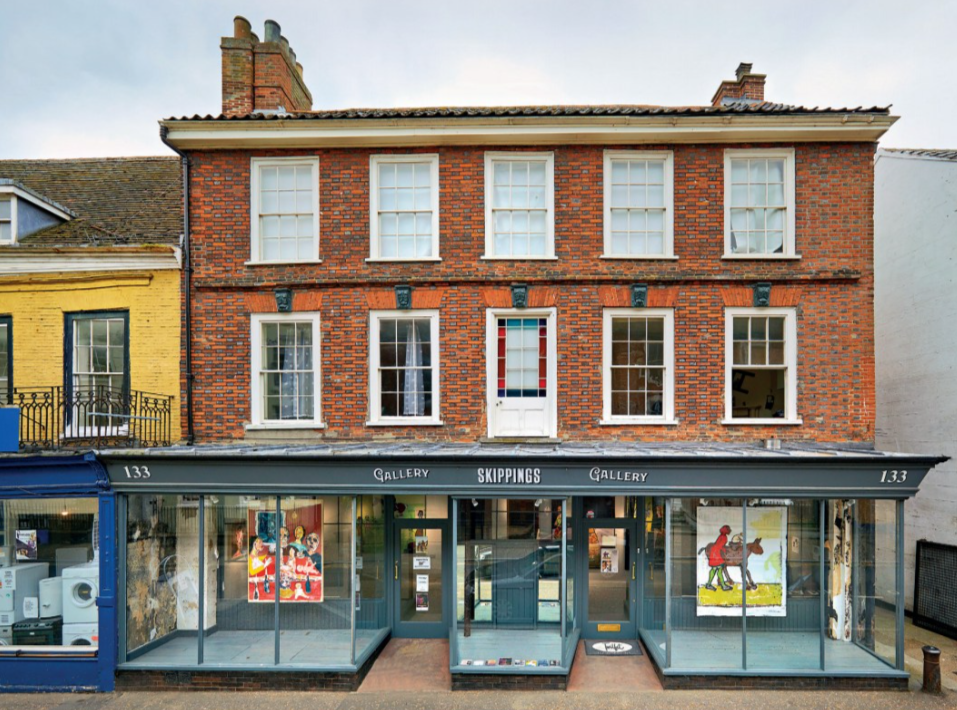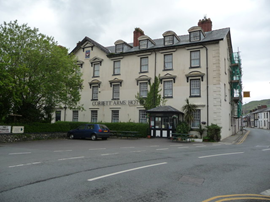Conserving Great Yarmouth's cultural heritage
Great Yarmouth Preservation Trust owns and manages a portfolio of historic properties, bringing them back into use, and building skills and employment opportunities.

|
| A restored building in Kings Street, now Skippings Gallery. |
Great Yarmouth grew from the North Sea on a shingle spit, and over the centuries has developed a multi-layered relationship and dependency on the sea. This unique interaction manifested itself through the fishing industry, ship building, navigation, international trade, the navy, immigration and as a vibrant seaside resort.
Maritime heritage resonates in our buildings, dialect, songs, stories, dance, and cuisine. In the townscape one can still appreciate that Yarmouth is an ancient town, with a medieval core enclosed by two miles of town wall, defensive towers and hundreds of narrow alleyways called rows. An enduring connection with the sea has shaped our identity and created a special sense of place.
Many traditional industries have disappeared, leaving tourism as Yarmouth’s single biggest business sector, representing 29 per cent of the district’s employment. More recently, the development of renewable energy sources, especially offshore wind power, has created future opportunities and opened new chapters in the town’s relationship with the sea.
Founded in 1979, Great Yarmouth Preservation Trust exists to preserve, safeguard and promote the cultural heritage of the borough. The trust owns and manages a portfolio of historic properties, bringing them back into use in ways that meet the needs of today’s residents, businesses and visitors, building skills and employment opportunities locally, and ensuring that historic buildings and spaces are maintained for the long term.
Using mortgages from Great Yarmouth Borough Council, the trust acquires at-risk assets and undertakes comprehensive repair, creating viable and sustainable end uses. The council requires robust business plans demonstrating a viable end use for each property, with sufficient income generated to service the loans. This approach has led to the creation of a gallery with artists’ studios attached, a community hub, a cafe, holiday lets in medieval towers, hairdressers, office spaces and high-quality, affordable housing. Since 2010, projects have generated £11.3 million for the local economy, removed 12 buildings from the buildings-at-risk register, created 25 residential units, delivered over 40,000 training hours, recruited 644 volunteers and led to 12 complementary projects. The trust manages the homes it delivers directly, and holds a lengthy waiting list for its residential property.
In Great Yarmouth educational attainment is below the regional and national average, so many people who live in the town lack the skills to access the highest-paid jobs in the energy sector, and many households rely on low paid and seasonal employment. Great Yarmouth’s unemployment rates were among the highest in the country prior to the outbreak of the pandemic. Skills levels, particularly in the heritage sector, are extremely low, resulting in poorly repaired and maintained heritage assets and general building stock. That contributes to deterioration and the town’s erosion.
In response to this, each trust project is developed around training and engagement. A strategy has evolved whereby entire projects are undertaken by volunteers and trainees under the close supervision of experts, from survey through to practical completion. There are many risks, but every step is painstakingly scrutinised, limitations are realised and accepted, and an extensive range of experts, professionals and craftspeople monitor, advise and mentor the process.
The benefits of this model are significant. They include a broad engagement, civic pride, a highly skilled and passionate workforce, and a repaired, preserved and properly maintained historic environment, all important parts of the trust’s strategy for reviving deteriorated and neglected areas of the town. By involving local people and providing meaningful opportunities in the preservation of the town’s heritage, an overlapping legacy is developed.
Rooted in the local community, the trust’s work not only improves the built environment in Great Yarmouth, but also develops the skills and employability of residents. A substantial outcome to this approach was for the trust to create a means to employ people trained on projects, who would then be able to use the skills they have acquired to continue maintaining Great Yarmouth’s heritage. In 2014 a trading company Norfolk Conservation Ltd was established, with a social enterprise remit and with the trust as the only shareholder, with any profits going to continue its charitable aims.
Before the pandemic the enterprise employed seven people, all of whom have worked as trainees on trust projects for at least four years. The creation of this company has helped to fill a vacuum, and demonstrates the benefits of effective and targeted training and engagement with mainly under-represented communities. Projects have included stone repair and consolidation, flint work, church monuments, and the ongoing repair and consolidation of Great Yarmouth’s medieval town wall. Importantly they provide a pool of conservation skills to local contractors.
Before placing training as a priority, Great Yarmouth lacked the basic skills needed to maintain historic buildings, such as working with lime mortar, window repairs, or traditional roofing techniques. There is still a long way to go, but much progress has been made in a relatively short time. Knowledge, understanding and an appreciation of traditional skills and appropriate repair techniques have created much-needed employment and ensured the preservation of the town’s heritage.
The backdrop to the trust’s work is familiar to many coastal towns. Great Yarmouth, like others, suffers a range of persistent social and economic issues. These have been compounded with the decline of high streets, the impact of the financial crash from 2007, the pandemic and, most recently, the cost-of-living crisis. As an example, in 2012 70 per cent of the retail space in the lower end of Kings Street was vacant, with the large number of neglected, boarded-up buildings contributing to a sense of decline in the town centre.
The trust’s focused and ongoing work on Kings Street has directly restored key buildings and acted as a catalyst for the owners of other King Street properties. The investment resulted in the opening of small shops such as barbers, news agents and grocers to service the growing community now living around the street. Many buildings on Kings Street are still in need of repair, but before the pandemic this part of Great Yarmouth’s town centre was widely felt to have turned a corner.
Supported by this early work and approach from the trust, in December 2020 Great Yarmouth Borough Council secured a £13.7 million investment from the government’s Future High Streets Fund to underpin further action to improve the town centre around the Market Place area. The trust also contributed to the council’s successful bid for £21 million of government investment through a Town Deal, acting as a partner to deliver a series of building repairs and training.
As a trading port on the edge of the east coast, the town’s rich heritage, culture and traditions have been firmly influenced by international connections, helping to shape a character that is truly distinctive. That character continues to evolve as communities shift and new influences arrive.
Great Yarmouth Preservation Trust puts significant emphasis on the value of sharing skills and exchanging knowledge, both between different parts of the local community, and between Great Yarmouth and other places that are working to maintain and improve their local environments in challenging conditions. Building on Great Yarmouth’s heritage as an important port for trade, the trust has fostered connections around historic trading links and partners on projects across Europe and Asia. The approach enables a broad community to collaborate locally and on an international level. Activities such as research projects, exchange visits, cross-border training and engagement through international partnerships have fostered greater learning and built transferable skills.
The process enables partnerships to be established with organisations, NGOs, universities, charities and groups. Partners share similar issues with Great Yarmouth, including low skill levels, or are connected by communities or by historic trade links. The driving motivation of all the partners is cooperation to share knowledge and provide meaningful opportunities for people to develop skills which can be used for the preservation of heritage.
Great Yarmouth Preservation Trust has benefited from a range of third-sector funding programmes, including Historic England, Headley Trust (part of Sainsbury Family Charitable Trusts), Pilgrim Trust and National Lottery programmes such as the Heritage Fund. The trust has received significant support from Architectural Heritage Fund, both through grant funding and sharing advice and expertise, and as a heritage development trust. A range of project partners has provided in-kind support for the trust’s projects.
Beyond grants, the trust is working to build resilience and self-sufficiency by growing its portfolio and a diversification of activities to generate revenue. It is working through a five-year strategy to build organisational sustainability, which will reduce dependency on funding bodies.
This article originally appeared in the Institute of Historic Building Conservation’s (IHBC’s) Context 175, published in March 2023. It was written by Darren Barker, managing director of Great Yarmouth Preservation Trust, who leads several international conservation training programmes in Europe and Asia.
--Institute of Historic Building Conservation
Related articles on Designing Buildings
IHBC NewsBlog
Images from inside a Grade II listed hotel show the scale of its collapse
The Corbett Arms in Tywyn has fallen into serious disrepair.
Old Sarum fire in listed (& disputed) WW1 Hangar - Wiltshire Council has sought legal advice after fire engulfed a listed First World War hangar that was embroiled in a lengthy planning dispute.
UK Antarctic Heritage Trust launches ‘Virtual Visit’ website area
The Trust calls on people to 'Immerse yourself in our heritage – Making Antarctica Accessible'
Southend Council pledge to force Kursaal owners to maintain building
The Council has pledged to use ‘every tool in the toolbox’ if urgent repairs are not carried out.
HE’s Research Magazine publishes a major study of the heritage of England’s suburbs
The article traces the long evolution of an internal programme to research 200 years of suburban growth
IHBC Context 183 Wellbeing and Heritage published
The issue explores issues at the intersection of heritage and wellbeing.
SAVE celebrates 50 years of campaigning 1975-2025
SAVE Britain’s Heritage has announced events across the country to celebrate bringing new life to remarkable buildings.
IHBC Annual School 2025 - Shrewsbury 12-14 June
Themed Heritage in Context – Value: Plan: Change, join in-person or online.
200th Anniversary Celebration of the Modern Railway Planned
The Stockton & Darlington Railway opened on September 27, 1825.
Competence Framework Launched for Sustainability in the Built Environment
The Construction Industry Council (CIC) and the Edge have jointly published the framework.















Comments
[edit] To make a comment about this article, click 'Add a comment' above. Separate your comments from any existing comments by inserting a horizontal line.